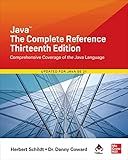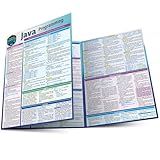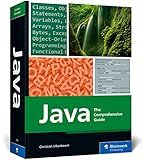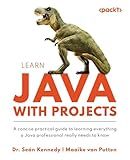Best Java Programming Books to Buy in December 2025

Java: The Complete Reference, Thirteenth Edition



Java for Beginners: Build Your Dream Tech Career with Engaging Lessons and Projects



Head First Java: A Brain-Friendly Guide



Java All-in-One For Dummies



Java Programming Language: a QuickStudy Laminated Reference Guide



Java: The Comprehensive Guide to Java Programming for Professionals (Rheinwerk Computing)



Java Coding Problems: Become an expert Java programmer by solving over 250 brand-new, modern, real-world problems



Learn Java with Projects: A concise practical guide to learning everything a Java professional really needs to know


In Java, collections are used to store and manage groups of objects. Some commonly used classes in the Java Collections framework include List, Set, and Map. List is an ordered collection that allows duplicate elements, Set is a collection that does not allow duplicate elements, and Map is a collection of key-value pairs. To use Java collections, you first need to import the necessary classes from the java.util package. You can then create instances of the desired collection class, add elements to it, remove elements from it, and perform various operations such as sorting, searching, and iterating over the elements. It is important to choose the appropriate collection class based on the requirements of your program, as each class has different characteristics and performance trade-offs. Overall, Java collections provide a powerful and flexible way to work with groups of objects in your Java programs.
How to use Java collections for storing and manipulating data?
Java collections framework provides several data structures and algorithms for storing and manipulating data. Here are some common ways to use Java collections for storing and manipulating data:
- Declaring a collection: To declare a collection, you need to import the necessary package and create an instance of the desired collection class. For example:
import java.util.ArrayList;
ArrayList numbers = new ArrayList<>();
- Adding elements to a collection: You can add elements to a collection using the add() method. For example:
numbers.add(5); numbers.add(10);
- Accessing elements in a collection: You can access elements in a collection using the get() method by providing the index of the element. For example:
int firstNumber = numbers.get(0);
- Removing elements from a collection: You can remove elements from a collection using the remove() method by providing the element itself or the index of the element. For example:
numbers.remove(0);
- Iterating over a collection: You can iterate over a collection using a for-each loop or an iterator. For example:
for (int number : numbers) { System.out.println(number); }
- Sorting a collection: You can sort a collection using the Collections.sort() method. For example:
Collections.sort(numbers);
- Searching for elements in a collection: You can search for elements in a collection using the indexOf() or contains() methods. For example:
int index = numbers.indexOf(10); boolean containsFive = numbers.contains(5);
- Using different types of collections: Depending on your requirements, you can choose different types of collections such as ArrayList, LinkedList, HashMap, HashSet, etc. Each type of collection has its own advantages and use cases.
By using Java collections effectively, you can store and manipulate data efficiently in your Java programs.
How to remove duplicates from a List in Java?
One way to remove duplicates from a List in Java is to use a Set to store elements without duplicates. Here is an example code snippet to achieve this:
List listWithDuplicates = new ArrayList<>(Arrays.asList(1, 2, 3, 1, 4, 2, 5)); Set setWithoutDuplicates = new HashSet<>(listWithDuplicates); listWithDuplicates.clear(); listWithDuplicates.addAll(setWithoutDuplicates);
System.out.println("List without duplicates: " + listWithDuplicates);
In this code snippet, we first create a List listWithDuplicates that contains some duplicate elements. Then, we create a new HashSet setWithoutDuplicates and pass the list as a parameter to the constructor. This will automatically remove duplicates from the list and store them in the set. Finally, we clear the original list and add all elements from the set to remove duplicates.
Alternatively, Java 8 introduced Streams which can also be used to remove duplicates from a List. Here is an example using Java Streams:
List listWithDuplicates = new ArrayList<>(Arrays.asList(1, 2, 3, 1, 4, 2, 5)); List listWithoutDuplicates = listWithDuplicates.stream().distinct().collect(Collectors.toList());
System.out.println("List without duplicates: " + listWithoutDuplicates);
In this example, we use the distinct() method on the stream to remove duplicates and then collect the elements back into a List using the collect() method with the Collectors.toList() collector.
How to synchronize a List in Java?
In Java, the Collections.synchronizedList() method can be used to synchronize a List. Here is an example:
List synchronizedList = Collections.synchronizedList(new ArrayList<>()); synchronizedList.add("Item 1"); synchronizedList.add("Item 2");
// Accessing a synchronized list should be done in a synchronized block synchronized(synchronizedList) { for(String item : synchronizedList) { System.out.println(item); } }
By wrapping the List with Collections.synchronizedList(), all access to the List will be synchronized using the intrinsic lock of the List. This ensures that multiple threads can safely access and modify the List concurrently without causing data corruption.
What is the difference between poll() and remove() methods in Queue interface in Java collections?
The main difference between the poll() and remove() methods in the Queue interface in Java collections is how they handle the case when the queue is empty:
- poll(): This method retrieves and removes the head of the queue, returning null if the queue is empty. It does not throw an exception if the queue is empty and simply returns null.
- remove(): This method retrieves and removes the head of the queue, throwing a NoSuchElementException if the queue is empty. It is used when you expect the queue to have elements, and want to handle the case when it is empty by throwing an exception.
In summary, poll() handles the case when the queue is empty by returning null, while remove() handles it by throwing an exception. It is up to the developer to decide which method to use based on their requirements.
What is the difference between Map and HashMap in Java collections?
In Java, both Map and HashMap are part of the collections framework and are used to store key-value pairs. The main difference between Map and HashMap is that Map is an interface while HashMap is a class that implements the Map interface.
Map is the parent interface of HashMap, and it defines the basic functionalities that a map data structure should have, such as adding and removing key-value pairs, checking for the presence of a key, etc. HashMap, on the other hand, is a concrete class that provides an implementation of the Map interface using a hash table.
HashMap allows null values and a single null key, while Map does not allow null keys. HashMap also does not maintain the insertion order of the keys, whereas LinkedHashMap, which is another class that implements the Map interface, does maintain the order of insertion.
In summary, Map is an interface that defines the basic functionalities of a map data structure, while HashMap is a class that provides an implementation of the map interface using a hash table.
What is the difference between HashSet and LinkedHashSet in Java collections?
The main difference between HashSet and LinkedHashSet in Java collections is the order in which elements are stored.
- HashSet does not maintain any specific order of elements, it uses the hash code of the objects to store them in a random order. It does not guarantee the order of elements when iterating through the set.
- LinkedHashSet, on the other hand, maintains the insertion order of elements. It uses a linked list to store the elements in the order they were inserted. When iterating through a LinkedHashSet, the elements are returned in the order they were inserted.
In summary, HashSet does not maintain any order of elements while LinkedHashSet maintains the insertion order of elements.
